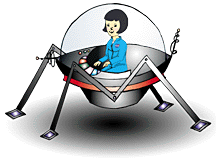![]()
 |
Imagine that!Dark energy is an even bigger concern to scientists than dark matter. Dark matter makes up about 23% of our universe today, while dark energy makes up 72%! |
|
In 1998, by observing distant supernova explosions, scientists came to the conclusion that the universe is expanding at a faster and faster rate. This was very surprising! Before that, it was believed that the universe would be either expanding at a constant rate or expanding at a slower and slower rate (due to gravity). So what causes the change in the expansion rate? The answer seems to be what scientists have called dark energy. At present, dark energy is a complete mystery. In fact, that is how it got its name - dark energy refers to the fact that some kind of something must fill the vast reaches of the universe in order to be able to make space accelerate in its expansion. But what exactly this something is is completely unknown to us. Several ideas have been pursued to explain or account for dark energy. One idea is related to the work of Albert Einstein who thought that space itself might contain energy. Another idea defines a new, fifth state of matter called quintessence (to go along with the usual four states of solid, liquid, gas, and plasma). Neither of these ideas has proven to work very well to explain what astronomers see happening in the universe. So it looks like it is up to future physicists (maybe you) to solve this important problem. |
|
A QuestionWhat observational evidence point to the existence of dark energy? |
| Did you know? |
The Answer |
![]()
The StarChild site is a service of the High Energy Astrophysics Science Archive Research Center (HEASARC), within the Astrophysics Science Division (ASD) at NASA/ GSFC.
StarChild Authors: The StarChild Team
StarChild Graphics & Music: Acknowledgments
StarChild Project Leader: Dr. Laura A.
Whitlock
Curator:
Responsible NASA Official: